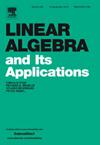Higham's approximations of polar factors of operators
IF 1.1
3区 数学
Q1 MATHEMATICS
引用次数: 0
Abstract
Let H be a complex Hilbert space and be the algebra of all bounded linear operators on H. For any operator , let and be the modulus and the Moore-Penrose inverse of A, respectively. The polar factor of an operator is, by the polar decomposition theorem, the unique partial isometry whose kernel coincides with that of A such that . In this paper, we show that if has closed range then the sequence converges to in the norm topology of . This extends Higham's matrix result to the setting of operators with closed range. Furthermore, we obtain another approximation of the polar factors of operators in and discuss a related linear preserving problem.
算子的极因子的海厄姆近似
设H为复希尔伯特空间,B(H)为H上所有有界线性算子的代数。对于任意算子a∈B(H),设| a |:=(a a)12, a†分别为a的模和Moore-Penrose逆。根据极分解定理,算子A∈B(H)的极因子是唯一的部分等距VA∈B(H),其核与A的核重合,使得A=VA|A|。在本文中,我们证明了如果A∈B(H)具有闭合范围,那么序列ex0 =A,Xn+1=12(Xn+Xn†),(n≥0)在B(H)的范数拓扑中收敛于VA。这将Higham的矩阵结果推广到具有封闭值域的算子的集合。进一步,我们得到了B(H)中算子的极因子的另一种近似,并讨论了一个相关的线性保持问题。
本文章由计算机程序翻译,如有差异,请以英文原文为准。
求助全文
约1分钟内获得全文
求助全文
来源期刊
CiteScore
2.20
自引率
9.10%
发文量
333
审稿时长
13.8 months
期刊介绍:
Linear Algebra and its Applications publishes articles that contribute new information or new insights to matrix theory and finite dimensional linear algebra in their algebraic, arithmetic, combinatorial, geometric, or numerical aspects. It also publishes articles that give significant applications of matrix theory or linear algebra to other branches of mathematics and to other sciences. Articles that provide new information or perspectives on the historical development of matrix theory and linear algebra are also welcome. Expository articles which can serve as an introduction to a subject for workers in related areas and which bring one to the frontiers of research are encouraged. Reviews of books are published occasionally as are conference reports that provide an historical record of major meetings on matrix theory and linear algebra.

 求助内容:
求助内容: 应助结果提醒方式:
应助结果提醒方式:


